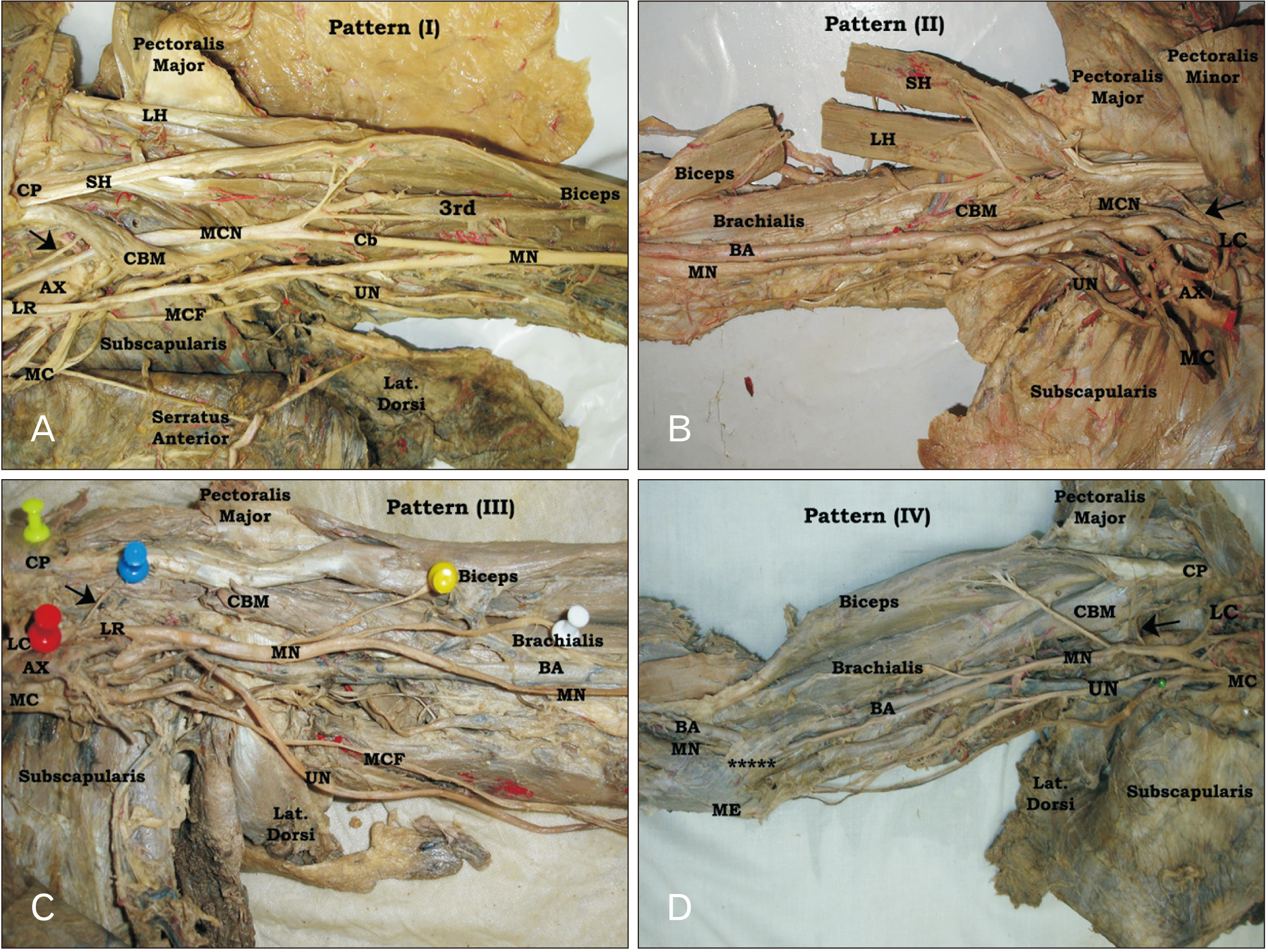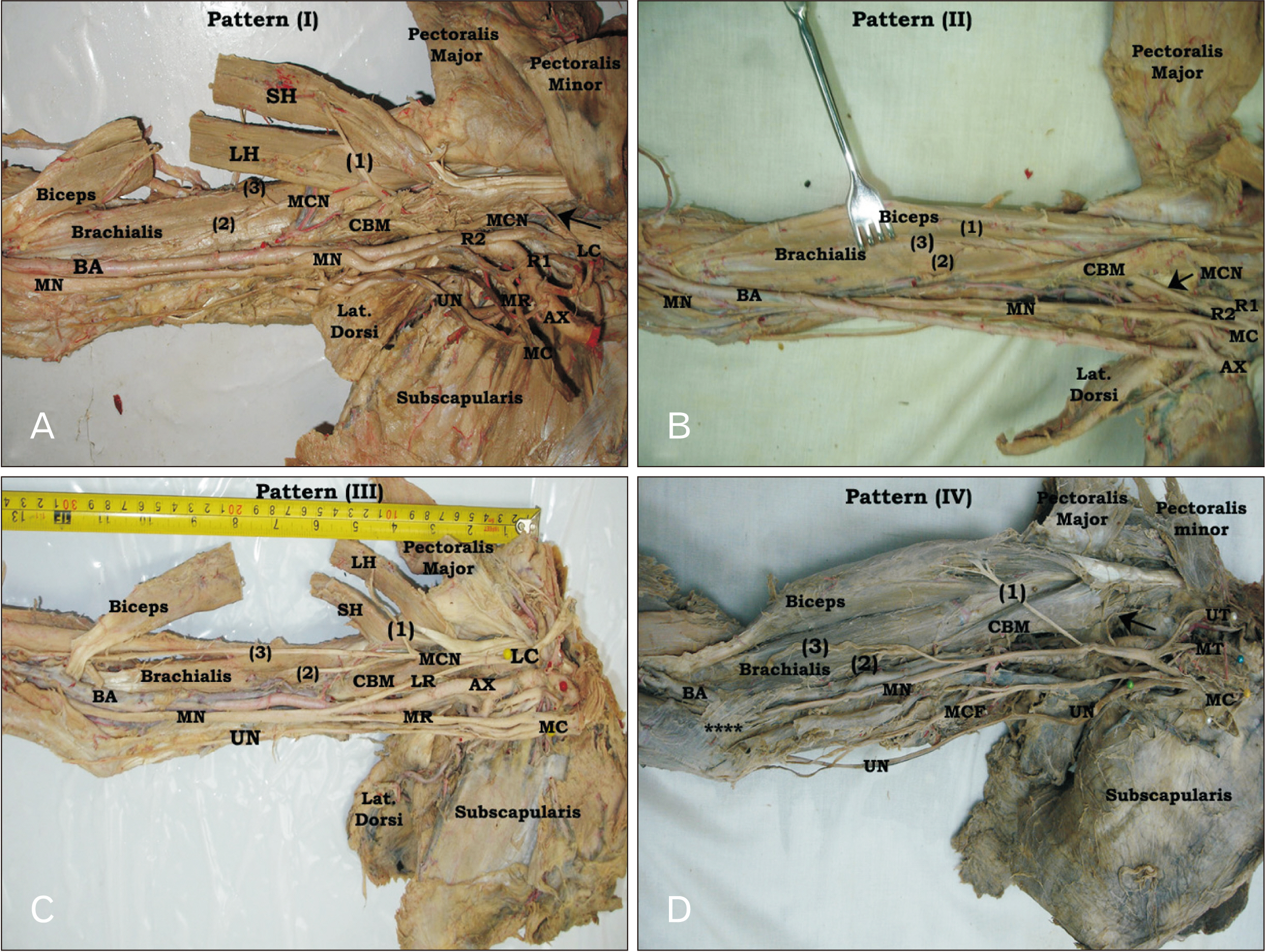Anat Cell Biol.
2024 Jun;57(2):194-203. 10.5115/acb.24.032.
Morphological classification, anatomical variations, innervation patterns, musculocutaneous nerve relation of the coracobrachialis muscle: anatomical study and clinical significance
- Affiliations
-
- 1Department of Clinical Anatomy, Faculty of Medicine, King Abdulaziz University, Jeddah, Saudi Arabia
- 2Department of Anatomy & Embryology, Faculty of Medicine, Zagazig University, Zagazig, Egypt
- 3Department of Neurology, Faculty of Medicine, Zagazig University, Zagazig, Egypt
- KMID: 2556563
- DOI: http://doi.org/10.5115/acb.24.032
Abstract
- The anatomical variations of coracobrachialis muscle (CBM) are of great clinical importance. This study aimed to elucidate the morphological variations, innervation patterns and musculocutaneous nerve (MCN) relation to CBM. Upper limbs of fifty cadavers (30 males and 20 females) were examined for proximal and distal attachments, innervation pattern of CBM and its relation to MCN. Four morphological types of CBM were identified according to number of its heads. The commonest type was the two-headed (63.0%) followed by the single belly (22.0%), three-headed (12.0%) and lastly fourheaded (3.0%) type. Moreover, an abnormal insertion of CBM was observed in four left limbs (4.0%); one inserting into the medial humeral epicondyle, the second into the upper third of humeral shaft, the third one in the common tendon of biceps, and the fourth one showing a bifurcated insertion. Also, four different innervation patterns of CBM were identified including MCN (80.0%), lateral cord (14.0%), lateral root of median nerve (4.0%), and median nerve itself (2.0%). The course of MCN was superficial to the single belly CBM (19.0%) and in-between the heads in the other types (71.0%). Measurements of the length and original distance of CBM muscular branches originating from MCN revealed no sex or side significant difference. Awareness of the anatomic variations, innervation patterns, and MCN relation of CBM is imperative in recent diagnostic and surgical procedures to obtain definite diagnosis, effective management and good outcome.
Figure
Reference
-
References
1. Johnson D, Collins P. Standring S, editor. Pectoral girdle and upper limb. Gray's Anatomy: The Anatomical Basis of Clinical Practice. 41st ed. Elsevier;2016. p. 783–7.2. El-Naggar MM, Al-Saggaf S. 2004; Variant of the coracobrachialis muscle with a tunnel for the median nerve and brachial artery. Clin Anat. 17:139–43. DOI: 10.1002/ca.10213. PMID: 14974102.
Article3. Georgiev GP, Landzhov B, Tubbs RS. 2017; A novel type of coracobrachialis muscle variation and a proposed new classification. Cureus. 9:e1466. DOI: 10.7759/cureus.1466. PMID: 28936378. PMCID: PMC5597060.
Article4. Georgiev GP, Tubbs RS, Landzhov B. 2018; Coracobrachialis longus muscle: humeroepitrochlearis. Cureus. 10:e2615. DOI: 10.7759/cureus.2615. PMID: 30027007. PMCID: PMC6044495.
Article5. Szewczyk B, Polguj M, Paulsen F, Podgórski M, Duparc F, Karauda P, Olewnik Ł. 2021; A proposal for a new classification of coracobrachialis muscle morphology. Surg Radiol Anat. 43:679–88. DOI: 10.1007/s00276-021-02700-1. PMID: 33564931. PMCID: PMC8105249.
Article6. el-Naggar MM. 2001; A study on the morphology of the coracobrachialis muscle and its relationship with the musculocutaneous nerve. Folia Morphol (Warsz). 60:217–24. PMID: 11552663.7. Olewnik Ł, Zielinska N, Karauda P, Duparc F, Georgiev GP, Polguj M. 2021; The co-occurrence of a four-headed coracobrachialis muscle, split coracoid process and tunnel for the median and musculocutaneous nerves: the potential clinical relevance of a very rare variation. Surg Radiol Anat. 43:661–9. DOI: 10.1007/s00276-020-02580-x. PMID: 32979058. PMCID: PMC8105253.
Article8. Loukas M, Aqueelah H. 2005; Musculocutaneous and median nerve connections within, proximal and distal to the coracobrachialis muscle. Folia Morphol (Warsz). 64:101–8. PMID: 16121328.9. Piagkou M, Tsakotos G, Triantafyllou G, Koutserimpas C, Chytas D, Karampelias V, Pantekidis I, Triantafyllou A, Natsis K. 2023; Coracobrachialis muscle morphology and coexisted neural variants: a cadaveric case series. Surg Radiol Anat. 45:1117–24. DOI: 10.1007/s00276-023-03207-7. PMID: 37464221. PMCID: PMC10514118.
Article10. Ilayperuma I, Nanayakkara BG, Hasan R, Uluwitiya SM, Palahepitiya KN. 2016; Coracobrachialis muscle: morphology, morphometry and gender differences. Surg Radiol Anat. 38:335–40. DOI: 10.1007/s00276-015-1564-y. PMID: 26464302.
Article11. Zielinska N, Duparc F, Polguj M, Borowski A, Olewnik Ł. 2022; A proposal for a new classification of the Coracobrachialis longus: a rare case or a new, distinct muscle? Ann Anat. 239:151825. DOI: 10.1016/j.aanat.2021.151825. PMID: 34481938.
Article12. Zielinska N, Olewnik Ł. 2022; Six-headed coracobrachialis muscle. Folia Morphol (Warsz). 81:809–13. DOI: 10.5603/FM.a2021.0082. PMID: 34608984.
Article13. Filippou D, Piagkou M, Natsis K, Chytas D, Kostare G, Triantafyllou G, Kostares E, Koutserimpas C, Totlis T, Salmas M, Karampelias V, Tsakotos G. 2023; A rare bilateral variant of the coracobrachialis muscle with supernumerary heads and coexisted variant branching patterns of the brachial plexus and the axillary artery. Surg Radiol Anat. 45:277–82. DOI: 10.1007/s00276-023-03088-w. PMID: 36693910. PMCID: PMC9981499.
Article14. Larrotta DRB, Porras PLF, Acuna LEB. 2018; Anatomic variations in relation to the origin of the musculocutaneous nerve: absence and non-perforation of the coracobrachialis muscle. Anatomical study and clinical significance. Int J Morphol. 36:425–9. DOI: 10.4067/S0717-95022018000200425.
Article15. Benes M, Kachlik D. 2021; Atypical branching of the musculocutaneous and median nerves with associated unusual innervation of muscles in the anterior compartment of the arm: case report and plea for extension of the current classification system. Surg Radiol Anat. 43:671–8. DOI: 10.1007/s00276-021-02731-8. PMID: 33689004.
Article16. Guerri-Guttenberg RA, Ingolotti M. 2009; Classifying musculocutaneous nerve variations. Clin Anat. 22:671–83. DOI: 10.1002/ca.20828. PMID: 19637305.
Article17. Remerand F, Laulan J, Couvret C, Palud M, Baud A, Velut S, Laffon M, Fusciardi J. 2010; Is the musculocutaneous nerve really in the coracobrachialis muscle when performing an axillary block? An ultrasound study. Anesth Analg. 110:1729–34. DOI: 10.1213/ANE.0b013e3181dc25c8. PMID: 20435937.
Article18. Tsakotos G, Triantafyllou G, Olewnik Ł, Georgiev GP, Koutserimpas C, Karampelias V, Zielinska N, Piagkou M. 2023; A bilateral symmetric accessory coracobrachialis muscle combined with an interconnection of the musculocutaneous nerve with the median nerve. Cureus. 15:e43496. DOI: 10.7759/cureus.43496. PMID: 37719489. PMCID: PMC10500966.
Article19. Saltzman BM, Harris JD, Forsythe B. 2015; Proximal coracobrachialis tendon rupture, subscapularis tendon rupture, and medial dislocation of the long head of the biceps tendon in an adult after traumatic anterior shoulder dislocation. Int J Shoulder Surg. 9:52–5. DOI: 10.4103/0973-6042.154769. PMID: 25937715. PMCID: PMC4410472.
Article
- Full Text Links
- Actions
-
Cited
- CITED
-
- Close
- Share
- Similar articles
-
- The anatomical variations of median nerve in Shiraz, Iran
- Unilateral Variation of the Median Nerve in a Human Cadaver’s Arm
- Communication between the musculocutaneous and the median nerves and its clinical significance
- Four-headed biceps brachii, three-headed coracobrachialis muscles associated with arterial and nervous anomalies in the upper limb
- An Isolated Musculocutaneous Nerve Palsy





